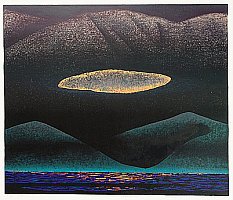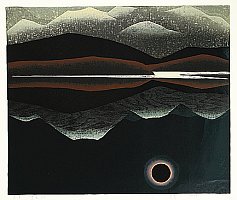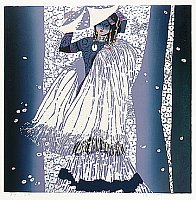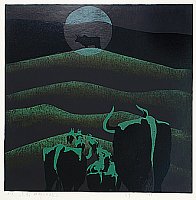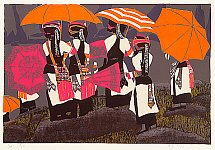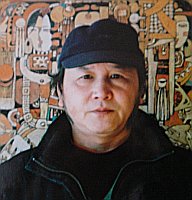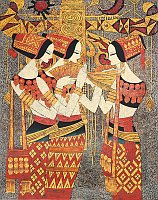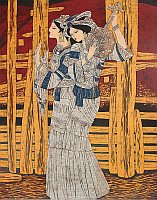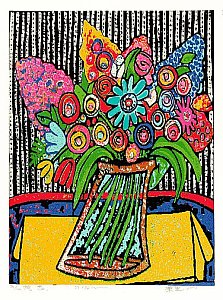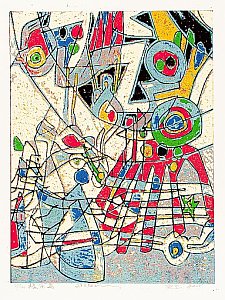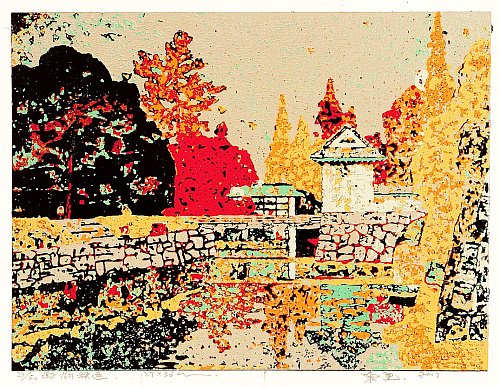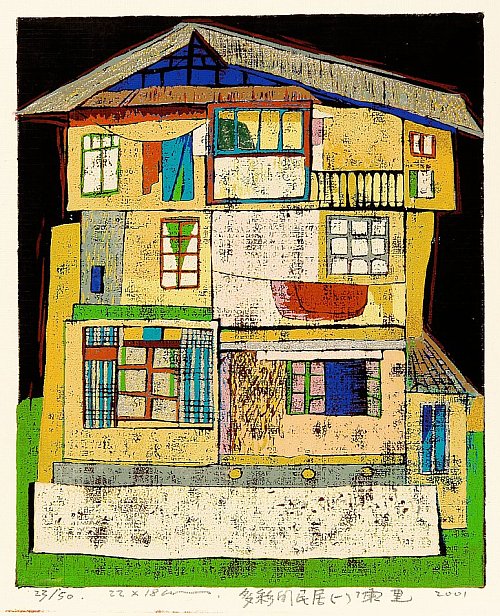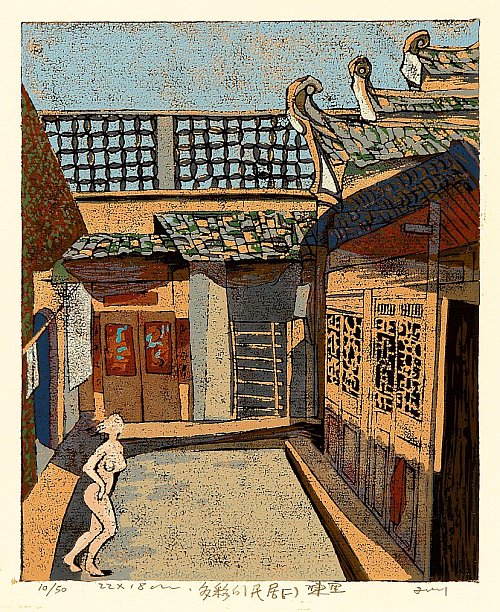Works by Li Xiu
Li Xiu - born 1943
Li Xiu is outstanding among China's leading artists in more than one way. First of all she is an excellent printmaker, secondly she is a woman artist and thirdly she belongs to the Yi ethnic minority in Yunnan.
Back Home after Graduation
The artistic breakthrough came for Li Xiu with a print titled Back Home after Graduation. It shows a girl from the ethnic Yi minority at her arrival by train back home. The print was done in 1977 and is kept in the style of the period - the style well-known from the Chinese propaganda posters. The image is beautiful and the art work made Li Xiu famous. The print was first shown at a national Chinese exhibition celebrating the "50th anniversary of China Prints". Later the art work went on a tour to France where it was shown to the French people.
After "Back Home after Graduation", Li Xiu began to work on several new series that turned out to be quite spectacular. They were titled "Ah, what a Horse Caravan" (1982), "The Quiet Lugu Lake" (1982). "The Years Dragging Long" (1984), "The Hengduan Mountains" (1988) or "Limpid Water" (1991).
Since "Back Home after Graduation" Li Xiu has experienced a great career as an artist and as an outstanding woman coming from an ethnic minority. Since then she has engaged herself not only in arts, but also in social and political issues promoting and supporting the role of women and ethnic minorities in China.
Editions, Technique and Style
Li Xiu's art style is not uninfluenced from what is today called the Yunnan Art School in modern printmaking. This term describes a certain direction in printmaking that has been born in Yunnan province and has over the last years become famous outside China as well. The common bonds are the use of strong and vibrant colors and the focus on depicting the exotic landscapes and the life and customs of a great variety of ethnic minority groups in this South-West province of China.
Li Xiu prints with rather thick oil-based inks comparable to the way how Hao Ping works - another artist from Yunnan. The edition size is small as usual for Chinese artists - at least for the 1980s and 1990s and the beginning of the new millennium. And as usual for Chinese artists, the prints are titled, dated, numbered and signed.
The art prints by Li Xiu have been a real challenge regarding the display of the images on the internet. The dark colors in connection with the use of glossy oil-based colors are a nightmare for a photographer. The images that we present you in our auctions of Li Xiu prints are in our view overall pretty good and close to the real thing. But nevertheless, we have the feeling that the actual prints are by far more impressive than the display of the digital images.
The prices of Li Xiu's art prints are not quite cheap. The artist has made only few prints per year. And the edition size is low. We regard the potential for future increases in value as high. Serious collectors of modern Chinese prints should not miss to take several prints by Li Xiu into their portfolio.
Milestones of an Artist Career
- 1964 - Graduation from the middle school associated with Yunnan Academy of Fine Arts.
- 1968 - Graduation from the printmaking department of Guangxi Academy of Fine Arts.
- 1980 - Admission to the Yunnan College of Arts for her woodcut creation.
- 1980 - Elected as a member of the China Printmakers Associations.
- 1985 - Elected as a member of China Artists Associations.
- 1992 - Invited for a visit to the United States of America.
- 1993 - Invited to visit Japan.
- 1993 - Li Xiu was elected as a permanent member of the 7th Political Negotiation Committee of Yunnan Province.
- 1998 - She was elected a permanent member of the 9th Standing Committee of the NPC (?) and vice-director of the National Minority Art Promotion Committee.
- 2001 - Li Xiu was invited to visit Britain, France, Italy, Austria and other countries.
Currently the artist works as a senior art teacher at Yunnan College of Arts.
Exhibitions
Li Xiu's art works have been regularly selected for the top art shows in China. For printmakers these are the annual National Print Exhibitions and the annual National Art Exhibitions. These art shows are juried. The artist has attended the 6th, 7th, 8th and 9th National Art Exhibition and the 6th, 7th, 8th, 9th, 10th, 12th, and 13th National Prints Exhibition. Apart from these annual major events, there are the following art shows that should be mentioned:
- 1988 - Solo show at China Art Gallery.
- 1992 - Solo show in Taiwan.
- 1985 - "Ten Female Printmakers" exhibition held by Chinese Artists Association.
- 1991 - The art work "Suspended Moon" was selected to attend the "Chinese Modern Art Exhibition" held by the Chinese Art Museum in Japan.
- 1993 - "Corona around the Mountain" was selected for the art show "30th Anniversary of Unique Collection Exhibition" in celebration of the establishment of the Chinese Art Museum.
- 1995 - The art works "Suspended moon" and "Limpid Water" were selected to attend the "Donated Artworks Exhibition of Famous Artists" held by the Yan and Huang Emperors Art Museum.
- 1995 - "July" was selected was selected for "Chinese Exquisite Paintings Exhibition".
- 1996 - "Limpid Water" was selected for "Chinese Modern Art Exhibition" held by the China Artists Association in Japan.
- 1999 - Art works by Li Xiu were selected to attend a roadshow exhibition of "Fifty Chinese Woodcut Artists" held by the British Woodcut Foundation Council.
- 2003 - Li Xiu was invited to contribute to the exhibition of "The Open Times" in celebration of the 40th anniversary of the Chinese Art Museum.
Prizes and Awards
- 1982 - The series of works "Ah, what a Horse Caravan" was awarded the first prize in the National Minorities Art Exhibition.
- 1991 - "Auspicious Clouds" received the copper prize in the 10th National Woodcut Exhibition.
- 1994 - "Limpid water" was awarded with the outstanding prize in the 8th National Art Exhibition.
- 1994 - "Spirit of Flower" won the golden medal in the National Minorities Hundred-Flowers Exhibition.
- 1997 - "The Tower" won the golden medal in the National Minorities Hundred-Flowers Exhibition.
- 1999 - Li Xiu received the prestigious Lu Xun prize for merits in printmaking. The Lu Xun prize is one of the highest and prestigious awards in China.
- 2001 - "The Primary Sun" received an award at the 5th National Minorities Hundred-Flowers Exhibition.
- 2001 - Li Xiu received the "Outstanding Artist's Prize" by the National Minorities Art Promotion Committee.
Collections
The following museums and institutions have acquired prints for their collection:
- The Chinese Art Museum shows 7 art works.
- The Art Museum in Sydney, Australia.
- The Hsiang Sen Forest Art Museum in Japan has 14 of the artist's works on display.
- The British Embassy in Beijing holds three art works by Li Xiu.
- The Shenzhou Print Museum is in possession of three works of art.
Publications
- 1985 - Article in the magazine "ART".
- 1989 - Article in "China Instruction" and "Chinese Women" (in English), published in Hong Kong.
- 1996 - "Woodcut Album of Li Xiu", ISBN 7-80586-305-9/J . 174, (in Chinese).
A Peaceful View of the Mountains
The following article was written by Crystal Lu and is published with friendly consent by the author and by Ms. Li Xiu. Copyright Mr. Crystal Lu. The contents expresses the personal likes and thoughts of the author about the artwork of Li Xiu. It does not necessarily represent the views of artelino.
The first time I knew the name of Li Xiu was about 20 years ago. Her artwork "Back Home after Graduation" attracted me so much that I wrote an essay to commentate on it. The print described a girl of Yi nationality getting off the train, with great joy. She had graduated from the school and just come back home.
The Yi nationality has a long history. The Yis have suffered a lot. They live in the remote mountains in the southwest of China. The print was created by a young printmaker - a Yi's artist from the southwest, who attracted the people's attention greatly.
Later Li became very famous. Her works still reflected the life of the Yis and the minority areas in the southwest. During a period of time, Li, just like the most part of the painters, created a lot of prints full of the local social customs and natural beauty in a realistic way, giving high praises to everything she loved.
In this prints collection, the pieces of works, such as "The Festival", "The Quiet Lake of LuGu", "A Suite of Paintings", "The Wind Rising", could be taken as representative of her own style. The characters of the Yi#s life, especially the Yi#s women, were depicted to a nicety, with delicate warm feeling, and the qualities of its enthusiasm were also revealed in the structures and the colors of the works. However, this kind of sentiment of realistic was used so often that her own character could not be displayed well. And her style also approached the popularity.
In the late 1980s, Li made great progress. Her print works, "The Crossing Mountains", which was a symbol of hers, made her so successful. In the autumn of 1988, while Li was holding her own exhibition in the Chinese Art Galley, I made a rough analysis on her change of art in an article titled "From the reality to the dreamy world", saying "The Crossing Mountains" gives people different conception, pure description, peaceful poetic feeling, dreamy imagery. It seemed that the feeling from the bottom of her heart had poured out and her skill and technique in art was sublimated to a high level.
The majestic mountains become so quiet like a spirit staring at the world with a pair of transparent but melancholy eyes. We enjoy the natural beauty of the mountains and are moved by the view, sinking into the dreamland, everything has become pure and clean.
Art is learned by heart, not depends on eyes or hand. She surmounted towards people to emerge a new world of her own. Her artworks "The Crossing Mountains", including four pieces of works, "A Mirror of the Mountain", "The Moon Suspended in the Sky", "The Corona around the Mountain" and "The Call", describe the lake on the top of the mountain, a herd of cattle in the moon light, the clouds in the sunset and the call of a pony in the valley.
The author emphasized to describe the horizontal mountain. The mountain presents a strong black, green and blue tone in the morning mist and the moonlight. It shows a wide and peaceful world. When you look at the painting, you will feel some kind of solitude. But the broad landscape makes you feel free from the world. When Li Xiu created these works, she was experiencing the harassment of life and was in a black mood. The purified imagery also expressed her desire of escaping from reality and having a peaceful life.
In 1989, Li went to sketch in Tibet. She said:
"The natural landscape there is similar to the high mountains in Yun Nan, but much more vaster and desolate. I was mostly moved by the Tibetans' religious belief and their expectation of a future life. I was attracted and walked into that world along with them."
In 1990, Li created four pieces of woks, "The Truth", "A Second Birth", "Auspicious Cloud" and "Fortune", which were the results of this kind of spirit surfs. These four pieces of works inherit the art skills of the print of "The Crossing Mountains" in style.
But it is a pity that in Li's two pieces of works, "The Truth" and "Auspicious Clouds", the mediums of the figures and the colors of the colorful ribbon and the clouds were not depicted simply, which reduces the integrity of the works.
"Limpid Water" are Li's recent works. The tone becomes cool, but the feeling of the prints is still quiet. I like the prints very much, especially one of the artworks. Rich and thick colors, the style tends to be lofty, which is the one that expresses the richest feeling in Li's works.
In the woodblock reduction prints, it is known that colors should be used less, black and white should be the most important in the tone. But few artists can handle this well. After the creation of the prints of "The Crossing Mountains", she has found out a way of expressing her feelings directly in her works. Both the figures and the colors are used simply. The spirit is put into the form of the works, the colors of black and white are very concordant.
In recent years, most of the woodblock reduction prints of Yunnan are so colorful, but Li puts a special emphasis on the colors of black and white. It is no doubt that an artist chooses a way of the vision and the language by his own style. Li Xiu insists on her pursuit in art. If she can keep on purifying the language, paying more attention to the lines and the shapes, making the structures and the colors more rhythmic, this will make her reach a new realm of art.
Compared with those works which have been created since 1988, "The Crossing Mountains" is more sensitive. That is to say, it is more subconscious of the printmaker. There is slightly feeling reflected in both the four Tibetan pieces of works and "Limpid Water". Maybe this is related to the artist's idiom. On the other hand, Li Xiu is very introverted. But she seems to be more enthusiastic and open-minded.
How to make an artist's creations (including the spirit and the way of language) and his own quality and character more harmonious, which will influence the creator's style and purity of art. It is necessary for the artists to think more about the problems they meet during their creation. It is said by some psychologists that the middle-age female will display some kind of male's personality, but for the artists, maybe it is not so good.
Since 1988, the factor of the reasonableness is gradually revealed in Li's artworks, especially in "Limpid Water". Perhaps this will put some infusion of coldness into her art style, which pushes her to a state of extremity. And it is possible to resemble the style of the American woodcut maker Kent. After all, Li Xiu is a frank painter, she is not grudging in doing that.
In my opinion, Li still has more emotions, which expends a peaceful view in the works of "The Crossing Mountains", composing it in figures. She was moved by the Tibetans' religous belief. But she does not realize that this kind of religious feeling is not proceed from reasonableness, but the feeling from the bottom of heart. The works, such as "The Crossing Mountains" and "The Truth", imply a certain kind of religious feelings.
The former faces to the nature, the latter expresses a person's imagination of religion. Compared with these two pieces of works, "The Crossing Mountains" reveals the artist's personal comprehend, reflects more characteristic and promote the emotion to the supernatural feeling by the dialogue with the world. That is metaphysics, some kind of religious experience. If Li Xiu pursues in this way, pouring her mental state of life and feelings in her works, her art style will be more pure.
Copyright ©2001-2011 artelino GmbH. All rights reserved








